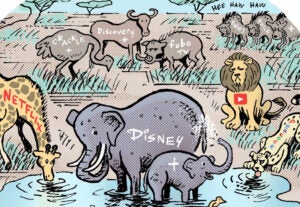
Anthony Rhind, global chief digital officer at global media agency Carat, describes programmatic as “an emerging operating system” for marketing effectiveness. It’s about much more than any one tool, such as RTB, or any one channel, such as display.
“To me the opportunity is ‘programmatic management,’ which means programmatic management of inventory opportunities, whether they’re fixed price or not,” he told AdExchanger at this week’s Programmatic I/O conference.
“It’s about understanding the value and maximizing the efficiency through programmatic channels, and then also using the real-time component for creative and design optimization and using that across programmatic bought inventory and nonprogrammatic bought inventory.”
AdExchanger caught up with him at the conference.
How is Carat Global executing programmatic management?
ANTHONY RHIND: It’s important to ensure that programmatic is addressed from a strategic planning perspective, rather than a buying optimization perspective. As an agency, we talk about convergence a lot and understanding that consumers are living their lives across multiple devices. They live in both a brick and a click world, and we have to plan for that. The data that can be amassed into DMPs is a really powerful planning tool, as well as an automated, algorithm-feeding, trading-intelligence engine.
We’re trying very hard to ensure that we’re pulling the intelligence out of the DMP infrastructure to feed into the strategic planning, the business outcome, modeling and processes. Feeding the granular digital data into the econometrics teams and allowing the data scientist to build mix models with a much deeper level of data, and then working at how to feed that into a much quicker decision-making protocol.
We’re doing a lot of work around that, to try and move what is great from an executional component to actually enrich the broader strategy development.
How can we think about programmatic management for mobile?
AdExchanger Daily
Get our editors’ roundup delivered to your inbox every weekday.
Daily Roundup
Mobile is the black hole of inventory management, and this is the year when search is going to move more to mobile from PC devices. We know that Facebook and Twitter usage is massively and predominantly on mobile, but if you look at the share of ad spend into mobile devices, or if you speak to the sell side and look at yield footprints for mobile inventory versus desktop inventory, you see that there’s a dreadful mismatch between audience time and monetization.
Part of that is creating ad formats that are effective in mobile and I don’t think we’ve done a good job yet. But I think video could be the inflection for that. Video is something that could work effectively in a handheld device format, much more so than a banner.
Obviously with Facebook really beginning to pump up their video product, that’s going to bring a lot of inventory in. And then you’ve got some innovative ad formats coming through. Some are using the term “out stream.” What they’re doing is creating high-quality video environments out of publisher websites that haven’t historically had video to offer. Video will go cross-device.
I think Atlas is very exciting, if what we hear they’re going to bring to market around Facebook ID-connected devices is true. [More on AdExchanger] All that is beginning to solve some of the attribution challenges, which means mobile is going to be taken more seriously, and because that’s still a relatively new space, we can make it programmatic from the start rather than move to a programmatic model.
What are the biggest challenges to understanding programmatic management?
We need to find a way to make the ad tech ecosystem simpler and more integrated. We have more and more point solutions and I spend a lot of time with clients trying to explain the ecosystem of ad tech. You might have an analytics ecosystem, a serving ecosystem, an optimization ecosystem, a data-management ecosystem or a verification ecosystem. The reality is that the client needs every single one of them and potentially different ones for desktop vs. mobile and maybe some different ones for video.
That means to cover all of those spaces, you might have to sell a client 10 or 15 different tools. At some point the client wants to know “where does this stop?”
I think we could do a better job of streamlining all of that. Now, there is the option of a Google stack, an Adobe stack or a Salesforce product. There are bundled products, but you actually have to break them out and there are gaps between them. You’ve got to understand what’s good and what’s got feature gaps, and that’s really hard.
Which is the most complete stack?
Obviously Google’s got the most penetrative and diverse stack. But that doesn’t mean it’s the best in all niches. Clearly, they have a significant gap in social and they’re moving into the DMP space.
There’s a point where having all your eggs in one basket is not desirable. A single stack gives you data integrity, which is really important. But at the same time, having a data-management infrastructure in place that allows you to work with best of breed also has very good merit.
How should the industry combat inventory opacity?
It is desirable to get to a point where inventory isn’t masked. If the buyer can see what they’re paying a price for, and can see what that individual component is delivering, they’ll value it higher or lower next time. What that will do is reward quality and get to a positive yield cycle rather than a negative yield cycle.
So where inventory owners are clearing some of their inventory in an open fashion, either through direct sales or through a private marketplace, and they’re exposing inventory through other marketplaces where the source of inventory is masked, what you’re doing is essentially teaching the buyer that they can buy the masked inventory to achieve the same outcome as they’re paying a higher price to receive from the visible inventory. That will pull more money to the masked side.
I think it’s very important for the publishers to control their own channel conflict, but also erosion of their own context value. The minimizing of URL masking is an important factor to creating a better marketplace where content is rewarded with yield.
The best part of knowing what we’re buying is that the value will be transparent, and that will create a desire to repeat what works. And if it works for my client, it’ll work for the client of another agency. We’ll start competing and we’ll get the yield elevation that is going to pull through more and more inventory into programmatic models.
What are the hurdles to programmatic’s global expansion?
One of the challenges is that cost of media varies so much. In markets where media is much cheaper than in North American markets, Western European markets and key Asian markets, the cost of media is getting lower and lower. And outside of those industry hotspots, it’s even lower, [such as] in Latin America, Southeast Asia or Central Eastern Europe. That creates friction in terms of deploying ad technology, because there is an understandable concern in marketers when they see a high percentage of media budgets being allocated to technology layers.
That’s one of the tension points for global roll out, getting pricing models around ad tech that allows it to be deployed into markets which might be tempted to buy a lot of inventory without targeting, without control, because they’re buying great audience coverage without the control benefits that the ad tech tools bring.
The answer there is global clients. We spend a lot of time creating a data strategy called global rollout with global partners. I think that’s the way we’ll hopefully pull through many of those markets because they’ll become beacons of best practice from the global advertisers that will create evidence and a community of super users. There’ll ultimately be cascade benefit, and how the global rollout of programmatic will continue to reverberate.














